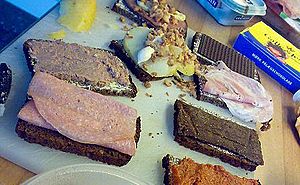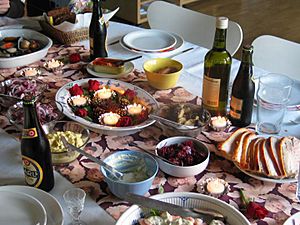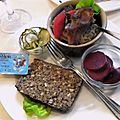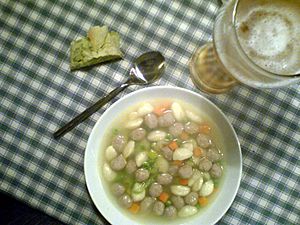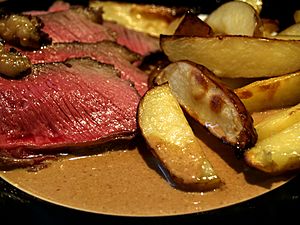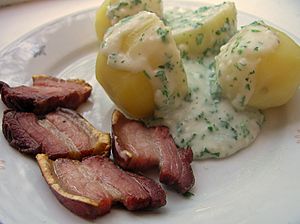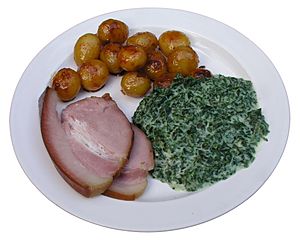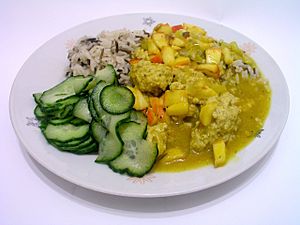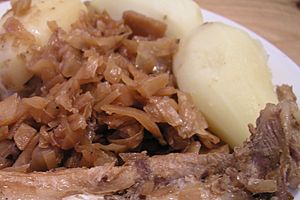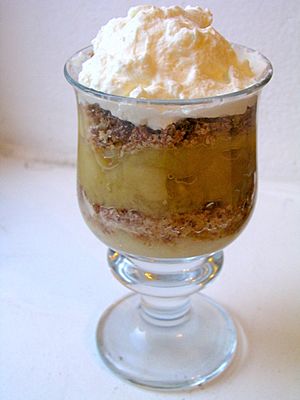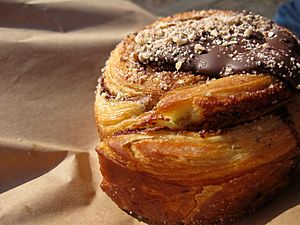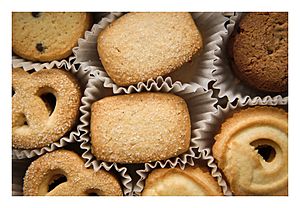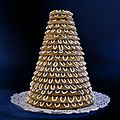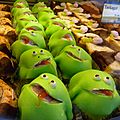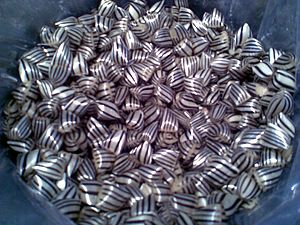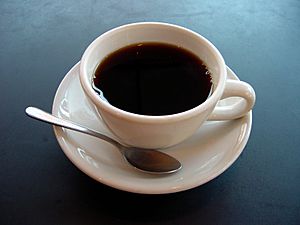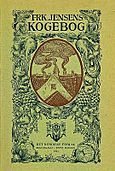Danish cuisine facts for kids
Danish food, called det danske køkken in Danish, comes from the simple meals of farmers long ago. It got better with new cooking ideas in the late 1800s and when more foods became available after the Industrial Revolution.
One special Danish food is smørrebrød, which are open-faced sandwiches. They are usually eaten for lunch. When made with many different tasty toppings, they are a national specialty! Hot meals in Denmark often have meat or fish. Popular dishes include flæskesteg (roast pork with crispy skin) and kogt torsk (poached cod fish) with mustard sauce.
During the Industrial Revolution, ground meats like pork, veal, or beef became very common. Traditional dishes still loved today are frikadeller (meatballs), karbonader (breaded pork patties), and medisterpølse (fried sausage). Denmark is also known for its beers, like Carlsberg and Tuborg, and for a strong drink called akvavit. However, many Danes have started drinking more imported wine since the 1960s.
Danish cooking has always been inspired by other countries. People used imported spices like cinnamon, cardamom, nutmeg, and black pepper even back in the Middle Ages. Some spices might have even been used by the Vikings!
Since the early 2000s, some Danish chefs have created something new called the New Nordic Cuisine. This way of cooking uses high-quality local foods. This new style has become very famous around the world. It has led to many great restaurants in Copenhagen and other parts of Denmark, with some even earning Michelin stars.
Contents
How Danish Food Changed Over Time
Danish cooking started with simple farm meals before the Industrial Revolution around 1860. Families used what they could grow or find nearby. So, foods like brassicas (like cabbage), bread, fish, pork, and later potatoes were common everywhere. Families stored dry foods like rye for bread, barley for beer, and dried peas for soup. They also smoked or salted pork to keep it longer.
When factories and new technologies arrived, people started eating more fresh meat and vegetables. But rye bread and potatoes stayed important. In the late 1800s, dairy cooperatives (groups of farmers working together) made milk more popular. Before that, people had eaten dairy products for thousands of years, but in smaller amounts.
New inventions like wood-burning stoves and meat grinders helped create many new dishes. These included frikadeller (meatballs), medisterpølse (fried ground meat sausage), hakkebøf (beef patties), karbonader (breaded pork patties), meat loaves, roast pork, poached cod, and stegt rødspætte (breaded flatfish). Desserts like rødgrød (stewed fruits or berries) and many cakes and cookies also became popular around this time.
For centuries, sausage and rye bread helped create smørrebrød. By the late 1700s, there were many kinds of sausage. Cold meat products became very popular in the 1840s when a French butcher opened a shop in Copenhagen. In the 1880s, Oskar Davidsen opened a restaurant that specialized in smørrebrød, offering a huge list of open sandwiches. Leverpostej (liver pâté) appeared in shops in the late 1800s.
Around the same time, lunch breaks became shorter, from one hour to 30 minutes. This encouraged people to bring smørrebrød in a lunch box to work. In the 1920s and 1930s, tomatoes and cucumbers were added to the toppings. In the 1940s, Henry Stryhn made leverpostej even more popular by delivering it around Copenhagen.
In the 1960s and 1970s, frozen foods and fast food became available. Danes also started traveling more, bringing back ideas from Mediterranean dishes. By the 1990s, Denmark was importing ingredients from warmer countries and growing new products at home. This led to a growing interest in gourmet (fancy) dishes. French cooking inspired many Danish chefs. They even showed how to make dishes like canard à l'orange (duck with orange) on TV.
A younger group of chefs traveled abroad to learn from French and Spanish cooks. They learned how to use local Danish ingredients to create beautiful and tasty Nordic dishes. Because of this, Danish chefs have made Denmark famous on the world food map. Many restaurants in Copenhagen and other areas now have Michelin stars.
New Danish Cooking Style
Danish cooking has also used old recipes in new ways, focusing on local foods and techniques that haven't been fully explored. Foods like rapeseed, oats, special cheeses, and old types of fruits are being rediscovered. Restaurants and home cooks are preparing them in new ways. People are also becoming more interested in local, organic foods.
The Nordic Council (a group of Nordic countries) supports these new food ideas. They have a plan to encourage using natural foods from Nordic countries in food production. This plan promotes "purity, freshness, simplicity, and ethics" in the region's food.
The Copenhagen restaurant Noma (which means 'Nordic food') was named the world's best restaurant by Restaurant magazine in 2010, 2011, 2012, and 2014.
In 2012, Danish chef and food activist Claus Meyer had his own TV show about Nordic cuisine on BBC Lifestyle. His book Almanak has 365 new recipes, one for each day of the year.
Main Meals in Denmark
Most Danes eat three meals a day. They usually have a cold breakfast with coffee or tea, a cold lunch at work, and a hot dinner at home with their family. Some people also have a snack in the afternoon or late evening.
Meat, especially pork, is the most common food for hot meals. It usually comes with potatoes and sometimes another vegetable like carrots or lettuce. Most hot meals have only one main course. Appetizers are rare, but desserts like ice cream or fruit are a bit more common. Beer and wine are often drunk with meals, but so are soft drinks, water, and sometimes milk or coffee.
Many families keep old traditions. Parents cook together and teach their children. Meals are an important part of family life. They are a time to talk and enjoy the feeling of well-being and coziness known as hygge.
Breakfast Foods
A basic Danish breakfast includes coffee or tea, and rye bread, white bread, or rolls with cheese or jam. Breakfast bread is often a white loaf called franskbrød (French bread), a baguette, or different white or brown rolls (boller, birkes, rundstykker, håndværkere). Sometimes people eat croissants. The bread usually has butter and is topped with soft cheese, sausage, pâté, cold meat, or jam.
For special gatherings or on Sundays, people might have a variety of bread rolls and wienerbrød, which is what Danish pastry is called in Denmark. Fruit juice, usually orange or apple, might also be served. Sometimes a bitter drink like Gammel Dansk is offered, especially for guests or on special days like birthdays. In Danish hotels, soft-boiled eggs and cold meats are also usually part of breakfast.
On weekdays, cereals like corn flakes, muesli, or rolled oats are often eaten with cold milk and sugar. Soured milk products are also popular, eaten plain or with cereal or fruit. A local soured milk product called ymer is topped with ymerdrys, a mix of dried grated rye bread and brown sugar. Porridges like oatmeal and a traditional local porridge called Øllebrød are also common on workdays. Øllebrød, a thin porridge made with rye bread bits, a light beer called hvidtøl, water, and sugar, is served with milk or sometimes whipped cream. It's becoming more popular and is now on many café breakfast menus.
Lunch Meals
Most Danes eat a quick lunch at work or school instead of going home. They might eat in a cafeteria if there is one. More often, they bring a packed lunch or madpakke from home. Lunch is usually a cold meal with a few simple pieces of smørrebrød (often called håndmad, meaning hand-food). These are topped with slices of cold meat, sliced sausage, or hard-boiled egg. Leverpostej, a liver pâté made from pig's liver and lard, is also a common spread.
Dinner Time
For most families, dinner is the one meal where everyone can be together. This is because both parents often work, and children are at school or daycare. It's a great time to talk about everyone's day. Dinner usually has one main course, often meat with potatoes and a vegetable or salad. Appetizers are rarely served at home. If there's a dessert, it's usually ice cream or fruit.
The types of evening meals have grown because supermarkets offer more foods and the local food industry has developed. American influences have made barbecues, salad buffets, and ready-to-serve dishes popular. Italian foods like pizza and pasta are also common choices. Meat is very popular, with pork being eaten most often. Meat cuts are often cooked in a frying pan and served with gravy and potatoes.
Sometimes, the evening meal is still called middag (midday). This is because hot meals used to be served in the middle of the day.
Open Sandwiches: Smørrebrød
Smørrebrød (meaning "butter and bread") is usually a piece of buttered rugbrød (rye bread), which is a thick, dark brown bread. Pålæg (meaning "that which is laid on the bread") is the topping. This can be cold cuts, pieces of meat or fish, cheese, or spreads. Fancy, well-decorated smørrebrød have made Danish open sandwiches famous around the world. One or two slices of pålæg are placed on the buttered bread and decorated with the right extras to make a tasty and good-looking meal.
Some traditional combinations include:
- Dyrlægens natmad (Veterinarian's late night snack): Liver pâté, salted beef, and meat jelly on rye bread. Decorated with raw onion rings and garden cress.
- Røget ål med røræg: Smoked eel on dark rye bread, with scrambled eggs, chives, and a lemon slice.
- Leverpostej: Warm liver pâté on dark rye bread, often with bacon and/or cooked mushrooms. Sometimes with lettuce and pickled or fresh cucumber.
- Roast beef: Thinly sliced on dark rye bread, with remoulade, shredded horseradish, and crispy fried onions.
- Ribbensteg: Thin slices of roast pork with crispy skin, on dark rye bread with rødkål (pickled red cabbage), and an orange slice.
- Rullepølse: Spiced meat roll with meat jelly, onions, tomatoes, and parsley. Usually pork, sometimes lamb.
- Tartar: Raw ground beef with salt and pepper on dark rye bread, topped with raw onion rings, grated horseradish, and a raw egg yolk.
- Røget laks: Slices of cold-smoked salmon on white bread, with shrimp, a lemon slice, and fresh dill.
- Stjerneskud (Shooting star): On buttered toast, two pieces of fish: steamed white fish (often plaice) on one half, and fried, breaded plaice on the other. Topped with shrimp, mayonnaise, sliced cucumber, caviar or black lumpfish roe, and a lemon slice.
Cold Buffet: Det Kolde Bord
Det Kolde Bord is a cold buffet served with bread for special occasions. The food is usually placed on the dining table for everyone to share. It's similar to the Swedish smörgåsbord, but with slightly different foods. Det Kolde Bord is usually served at lunchtime, but it can last into the evening.
The meal starts with seafood, often pickled herring. There are many kinds of pickled herring. White herring is marinated in a clear, sweet, and mildly spiced vinegar sauce. Red herring has a stronger taste and is marinated in a red, seasoned vinegar sauce, colored by sandal wood. Other common types include sauces made with sour cream, especially a popular curry-flavored one.
Pickled herring is usually served on buttered, dark rye bread. It's topped with onion rings, pickled capers, and a spoonful of curry salad (a sour-cream sauce with curry and chopped pickles). Chopped hard-boiled eggs are served on the side. Other common herring dishes at the cold buffet include fried herring in vinegar or more elaborate herring dishes with warm, boiled potatoes, raw onion, pickled capers, and a dill-flavored sour-cream or mayonnaise sauce. Diced apple, shredded horseradish, and curry salad are also popular additions.
Other seafood dishes might include:
- Rejer (shrimps), usually on white bread with mayonnaise and lemon.
- Røget ål (smoked eel) with scrambled egg.
- Gravad laks (salt-cured salmon) with a dill and mustard sauce.
- Rødspættefilet (breaded filets of plaice), served hot with lemon and remoulade.
- Røget laks (smoked salmon).
- Røget hellefisk (smoked halibut).
The cold table also has many meat dishes. Even though it's called "cold," it almost always includes some hot items. Some common parts are:
- Frikadeller (meatballs), sometimes hot.
- Leverpostej (liver paste), sometimes hot, with pickled beetroot, mushrooms, or fried bacon.
- Mørbradbøf (pork tenderloin), hot, with fried onions.
- Flæskesteg (roast pork) with crispy skin, usually with red cabbage.
- Medisterpølse (a thick, fried pork sausage).
- Pariserbøf (ground beef steak), usually served hot on toast with pickles.
There might also be cold cuts like ham, roast beef, salami, beef brisket, and spiced roulade. Det Kolde Bord usually includes side dishes like potato salad, scrambled egg, and various other salads. Desserts like fruit salad and fruit pies, as well as different cheeses, may also be served. Around Christmas, the buffet sometimes has sylte (meat jelly from pork) and other Christmas specialties.
Dinner Choices
For most Danish families, the everyday evening meal is a main course and maybe a dessert. On weekends and special days, a more elaborate meal is served. Good restaurants usually offer a three-course dinner. Even though many foreign foods are available in Denmark, traditional dishes are still popular. Here are some common dinner options.
Appetizers
The first course is typically fish or soup, but many other appetizers are becoming more common. Common traditional appetizers include:
- Shellfish: Mussels, shrimp, oysters, crab, and lobster. Usually cooked and served with white bread and various toppings for an appetizer or small meal.
- Shrimp (rejer) usually come from Greenland or the North Atlantic. Small, flavorful fjord shrimp from Denmark are a seasonal treat. Special shrimp appetizers include shrimp cocktail (rejecocktail), shrimp salad (with mayonnaise), and shrimp terrine. Shrimps also top some fish dishes.
- Mussels (muslinger) are caught and farmed a lot in Danish waters and are served cooked. Blue mussels are the most common, but razor clams, green-lipped mussels, and common cockles are sometimes served. Like shrimp, mussels can be part of some fish dishes.
- Oysters are usually served raw, and sometimes smoked, as an appetizer for fancier dinners.
- Fish served as an appetizer or main dish includes pickled herring and gravad laks (cured salmon) served cold with bread. Rye bread goes with herring, and white bread with salmon. There are many kinds of pickled herring, including smoked or fried pickled herring. Fish pâtés with bread are also common.
Soups
Soup is often a meal by itself and is usually served with bread. It can also be an entrée (first course) before the main dish. Besides soups found in other countries, Danish specialties include:
- Gule ærter (pea soup): A hearty meal served with salted pork, carrots, and other vegetables.
- Hønsekødssuppe (chicken soup): Served with melboller (small flour dumplings), meatballs, and cubed vegetables.
Main Dishes
Fish, seafood, and meat are very important parts of traditional Danish meals. With a long coastline and many small islands, Denmark has a strong tradition of fishing, so seafood is naturally a big part of Danish food.
The most common fish and seafood eaten are:
- Cod (torsk): A common white fish used in many ways (baked, steamed, poached). It's also dried (klipfisk). Danes especially like cod's roe (eggs). Cod prices have gone up, so other white fish like haddock and ling are often used instead.
- Norway lobster (jomfruhummer).
- Herring (sild): Very important in traditional Danish food. Served in many ways: smoked, fried, pickled, breaded, or charred.
- Plaice (rødspætte): Often served as fried, battered fish fillets or as a white fish in general cooking. It's often replaced with the more common European flounder, called skrubbe in Danish.
- Eel (ål): Smoked or pan-fried. Smoked eel is a favorite in some homes.
- Salmon (laks): Poached or broiled and served in many ways. Smoked and cured salmon with bread are for appetizers or smørrebrød.
- Roe (rogn): Fish eggs. Cod roe is the most common, but lumpfish roe (stenbider) is also served sometimes. Poached or pan-fried is typical. Salmon roe is used as a topping for some seafood dishes.
Fish from Bornholm, Iceland, and Greenland are also special in Danish cooking. Bornholm, an island in the Baltic Sea, is known for its smoked fish. Iceland and Greenland have long ties with Denmark, and their fish is seen as high quality.
Pork is the favorite meat in Denmark. Pork has been a major export for over 100 years. At home, Danes eat mostly pork (42%), then poultry (28%), and beef (26%). These numbers are from 2016 and don't include processed meats or eating out. Processed meats in Danish cooking include a lot of pork, like hams, smoked pork, cold cuts, sausages, and salamis. So, the actual pork consumption is even higher. Ground pork is used in many traditional recipes. Danish bacon is generally good quality.
Beef is also very popular in modern Danish kitchens. Danish cows were mainly used for dairy, and Denmark has a long history of dairy products. So, cows raised just for meat used to be rare and expensive. Dairy cows don't usually make good meat, especially after years of producing milk. Because of this, beef was traditionally ground and cooked as patties or prepared as boiled roasts or soups. Today, meat-specific cattle are more common, and steaks are popular. Top sirloin steak of beef (culottesteg) is a classic dish for guests.
Chicken is the most popular poultry, with chicken fillet being the top choice. Danes still eat a lot of meat, but in the 2010s, vegetables and vegetarian food have become a bit more popular. Also, people tend to replace other meats with chicken.
Traditional Main Course Dishes
Many traditional dishes have become less common in Denmark in the last 40-50 years, especially those that take a long time to prepare or use organ meat. Quick meals, pre-cooked foods, and foreign-inspired cooking have become more common in Danish homes. Traditional Danish main course dishes include:
- Boller i karry (Dumplings in curry): Pork meatballs in curry sauce, served with rice.
- Gammeldags kylling (Old-fashioned chicken): Whole pot-roasted chicken stuffed with parsley. Served with boiled potatoes, thick brown sauce, cucumber pickle, and rhubarb compote.
- Frikadeller: Pan-fried meatballs made of pork, or a mix of veal and pork, with spices. There are many ways to make them. They can be served with various hot and cold side dishes. Stuvet hvidkål (stewed white cabbage in white sauce) is a classic side.
- Hakkebøf: Ground beef steak. Traditionally served with soft caramelized onions (on top), brown sauce, boiled potatoes, and pickled beets or cucumbers.
- Hjerter i Flødesovs (Hearts in cream sauce): Calf's hearts are cleaned, stuffed with parsley and smoked bacon or pork fat. They are seasoned and fried in a pot with butter and onions. Broth and cream are added, and they simmer for 1½ hours. The hearts are sliced and served with the sauce, mashed potatoes, and surt (a general term for pickled vegetables).
- Stegt lever (Fried liver): Fried slices of calf's liver served like hakkebøf, but without pickles. Sometimes with fried mushrooms. Pig's liver is often used instead.
- Stegte sild (Fried herrings): Herring has always been popular. There are many recipes for fried, pickled, or smoked herring served as a main course.
- Æbleflæsk (Apple-pork): Fried pork slices served with a compote of apple, onion, and bacon.
- Stegt flæsk med persillesovs: Slices of fried belly pork with persillesovs (white sauce with chopped parsley) and potatoes. In 2014, this was voted the national dish.
- Medisterpølse: Thick, spiced, minced pork sausage, fried and served in many ways. Rødkål (red cabbage), rye bread, and mustard are classic sides.
- Gule Ærter (Yellow peas): A thick, hearty soup of yellow split peas, cooked and served with pork. Served with rye bread and mustard, and sometimes medisterpølse and potatoes. In some families, Gule Ærter is eaten at specific events or large gatherings.
- Hønsekødssuppe (Hens-meat-soup): A strong soup made from a large hen with herbs and vegetables like carrots, celeriac, onions, and leeks. The meat is usually saved for other dishes like Høns i Asparges or chicken salad for smørrebrød. The soup is served on its own with pork meatballs (kødboller), small white flour and milk dumplings (melboller), and some of the vegetables.
- Høns i Asparges (Hens in Asparagus): Boiled chicken meat (often from Hønsekødssuppe) cooked with a little chicken soup, flour, and chopped white asparagus. Sometimes chopped mushrooms are added. The dish is thickened and flavored with cream and egg yolks. Served with boiled potatoes and a sprinkle of parsley.
- Tarteletter (Tartlets): Small pastry cups. They can be filled with many things, but traditionally they hold Høns i Asparges.
- Æggekage (Egg-cake): Similar to an omelette. Traditionally served in the pan with fried bacon, sliced tomatoes, lots of chopped chives, and buttered rye bread. Smoked herring is sometimes offered on the side.
- Påskelam (Easter-lamb): Grilled lamb with dry herbs and garlic.
- Culottesteg: top sirloin roast beef with dry herbs. Served with potatoes and green salad or gravy.
- Stegt gås: Roast goose is sometimes served for Christmas.
- Stegt and: Roast duck prepared like roast goose, stuffed with apples, prunes, and thyme. This is the most popular Christmas dish in Denmark, often with flæskesteg and almost always with rødkål. Also served on Morten's aften (St. Martin's Day, November 11), replacing an older tradition of roast goose.
- Flæskesteg: Roast pork with crispy skin, often served at Christmas.
- Rødkål: Sliced and stewed red cabbage. Recipes vary, but almost always include vinegar, sugar, and some spice. Cinnamon, bay leaves, and cloves are common. Other recipes add allspice or cardamom. Apples, onions, and sometimes oranges or red wine might be added. For fancier versions, the cabbage is stewed with duck fat. Served for Christmas, but also with flæskesteg, medister, frikadeller, stegt and, and stegt gås.
- Brunede kartofler (Browned potatoes): Boiled potatoes caramelized with sugar and butter. Mostly served for Christmas with roast duck, goose, or pork.
- Øllebrød (Beer-bread): A porridge made of rye bread, sugar, and beer. It used to be served unsweetened with main courses like fried herring. Now, it's almost always a breakfast dish with cold milk or whipped cream. Lemon or orange zest is sometimes added.
- Millionbøf (Million-steak): Fried ground beef (like a million tiny steaks) with gravy. Usually served over pasta or mashed potatoes.
- Brændende kærlighed (Burning love): Mashed potatoes made with butter and milk or cream. A hole is made in the top and filled with fried diced bacon and onions.
- Risengrød: (Rice-porridge): A dish with a special connection to Christmas. It's traditionally the favorite food of the Nisse (a mythical creature). Usually served with butter, cinnamon sugar, and a special Christmas beer called nisseøl. It's also the base for the Danish Christmas dessert Risalamande.
Desserts
Popular traditional Danish desserts still enjoyed today include:
- Æblekage (apple charlotte): Stewed sweetened apples layered with butter-roasted bread crumbs and crushed makroner (almond-flavored cookies). Topped with whipped cream and sometimes redcurrant jelly. Served cold.
- Citronfromage (lemon custard): A very thick lemon-flavored custard made with gelatin and beaten egg whites with sugar (like Meringue). Served cold with whipped cream. A traditional variation is Romfromage, flavored with rum instead of lemon.
- Karamelrand (Caramel-ridge): A cream and egg custard flavored with caramel and shaped like a ring. Served cold with caramel sauce. Fløderand is a traditional variation flavored with vanilla and served with pickled fruit instead of caramel.
- Frugtsalat: Fruit salad topped with vanilla cream or whipped cream and grated chocolate. This is a newer Danish dessert. Tropical fruits like banana, grapes, orange, or pineapple are common ingredients. Also known as abemad (monkey food).
- Rødgrød med fløde: Stewed, thickened red berry compote (usually strawberries, rhubarb, raspberry). Served with cream or as a topping on ice cream.
- Pandekager: Thin, crepe-like pancakes, often sprinkled with confectioner's sugar, rolled up, and served with strawberry jam or vanilla ice cream. Since 2006, Shrove Tuesday is celebrated as Pancake Day in Denmark.
- Koldskål: A sweet, cold buttermilk dish with vanilla and lemon, often served in the summer.
- Danish strawberries with cream and sugar: Served in the summer when they are in season.
- Risalamande (or ris à l'amande): A cold rice pudding mixed with whipped cream, sugar, vanilla beans, and chopped almonds. Served cold with hot or cold cherry sauce. Almost only served at Christmas, especially on Christmas Eve.
Cakes
Cakes are usually not served as dessert in Denmark. Instead, they are an occasional sweet treat between meals or at celebrations. Coffee or tea is usually offered with cakes.
The region of Sønderjylland is known for its Sønderjydsk kaffebord. This is a gathering where lots of coffee and regional cakes are served in the afternoon. Typical Danish cakes include:
- Wienerbrød (Danish pastry): Denmark has many kinds of Danish pastries. Most recipes use the same type of dough.
- Kringle: A pretzel-shaped Danish pastry. It has been a symbol for bakers in Denmark since the Middle Ages. In the United States, "kringle" is linked to Denmark.
- Kagemand ("cake-man"): A Danish pastry shaped like a man. Decorated with icing and candy. Traditionally served at children's birthday parties. In a fun game, the head is cut off while children scream loudly before serving.
- Småkager ("small-cakes"): Cookies, usually baked hard and crispy. There are many kinds of småkager in Denmark. Most recipes came about when stoves became common in the late 1800s. Some, like Klejner and Pebernødder, have been around since the Middle Ages. Many recipes are for Christmas. Denmark exports a lot of good butter cookies.
- Pebernødder: ("pepper nuts") Small, spicy cookies for Christmas. Used in many games.
- Vaniljekranse: Vanilla-flavored butter cookies shaped like a ring.
- Flødekager ("cream-cakes"): These cakes get their name from the generous amounts of whipped cream used. They are served cold. Many types don't even include baked ingredients. They became popular in the 1800s and 1900s when Konditorier (Danish versions of French patisseries) became popular in larger towns. They were very popular in the 1940s and 1950s.
- Lagkage (layer cake): This cake has thin sponge cake layers, often with mashed berries and whipped cream or custard between them. Decorated with fruit on top. Layer cakes are usually considered a flødekage. They are often used for birthdays. Traditionally, they are decorated with candles equal to the person's age. The person tries to blow them all out in one go for good luck. Some Danish layer cakes follow strict recipes, like Rugbrødslagkage (made with crumbled rye bread) or Othellolagkage (made with marzipan and chocolate cream).
- Gåsebryst ("Goose breast"): Has a crispy puff pastry bottom with prune jam and a thick layer of whipped cream. The cake is wrapped in a thin layer of marzipan. This cream cake is also popular in Norway.
- Tørkager ("dry-cakes"): As the name suggests, these are dry cakes, compared to moist cream cakes. They are often made with sweet shortcrust dough and served cold.
- Kransekage ("ringcake"): A marzipan-based cake, usually served at special celebrations and on New Year's Eve. It comes in different shapes and sizes. A popular way to serve it is as a stack of rings, getting smaller towards the top, forming a cone. The rings are decorated with white icing and small red-and-white Danish paper flags. For special occasions, a bottle of champagne might be hidden inside. Kransekage is typically served with champagne on New Year's Eve, or for weddings, "round" birthdays, and anniversaries.
- Studenterbrød ("graduates-bread"): A popular cold cake with thick cookie butter on a thin, crispy shortcrust base, with raspberry jam in between. The cookie butter is flavored with cocoa powder and rum (though often cheaper rum essence is used). Topped with chocolate icing and sprinkles.
- Hindbærsnitte ("raspberry-slice"): Two thin, crispy baked shortcrust pieces with raspberry jam in between, covered in white icing and sprinkles. Similar to Alexandertorte.
- Pies and tarts:
- Strawberry pie: Very popular in the summer. Usually sold in bakeries with a chocolate-covered crust and marzipan filling.
- Apple pie: Baked in the oven. Served hot or cold, usually with a dollop of crème fraîche or whipped cream, sometimes vanilla ice cream.
- Other cakes:
- Æbleskiver ("apple slices"): Fried round cakes made in special pans. Despite the name, they are not made with apples. They are made from a puffy pancake dough with buttermilk and cardamom. Danes eat them hot throughout December as a Christmas tradition, served with both confectioner's sugar and jam (strawberry or black currant).
- Pandekager (pancakes): Thin pancakes usually served with jam, granulated sugar, and sometimes vanilla ice cream. They are rolled up before eating.
Sweets and Candy
Danes eat more candy per person than most other countries.
- Chocolate: Denmark has a long history of making delicious chocolate. Anthon Berg is a famous brand.
- Liquorice: A very popular flavor in Denmark. Used in many sweets, ice cream, desserts, and some dishes. Salmiaklakrids, flavored with salmiak, and salty Salt lakrids are typical Danish candies. Denmark makes some of the strongest liquorice in the world. Many Danes like to put liquorice on everything, which foreigners sometimes find surprising.
- Marzipan: A typical Christmas treat, but enjoyed all year and also exported. Marzipan in Denmark is usually less sweet and has more almonds (or other nuts) than what you find elsewhere. Anthon Berg is a well-known exporter. In Denmark, only Ægte Marcipan (True Marzipan) must contain almonds. For regular marzipan, apricot kernels are often used instead of more expensive almonds. Marzipan made with pistachios or walnuts is also sold but is less common.
- Wine gums: While they look similar to those in other European countries, Danish wine gums are less sweet and have more chewiness.
There are also many other types of sweets and candy, from gumdrops and dragée to mints and caramel sweets. Bland selv slik (meaning "mix-yourself candy") is common in Danish supermarkets and kiosks. You can choose from many different kinds of candy in containers, scoop them into a paper bag, and then pay by weight. Both Danish and imported candies are found in these assortments. The shapes, textures, and flavors are often very creative, like candies shaped like flying saucers, tennis rackets, or even teeth.
Drinks in Denmark
Traditional or popular drinks in Denmark include:
- Coffee (Kaffe): Filter coffee is the most popular way to make coffee, followed by French press. Coffee is mostly drunk black, but milk and sugar are usually offered. It's drunk throughout the day and evening, and always in the morning. Nearly all cafés offer many kinds of coffee, from espresso to flat white and caffè latte. Coffee is very popular in Nordic countries. Denmark has the fifth highest coffee consumption per person in the world.
- Chocolate milk (kakaomælk) and hot chocolate (varm kakao): Cold chocolate milk is widely drunk. Hot chocolate can be found in most cafés. At home, hot chocolate is often served to children as an important part of family hygge.
- Hyldeblomstsaft: Sweetened elderflower drink, often mixed at home with water. Sometimes served hot in winter, but usually cold.
- Danskvand or hvid vand: Simply carbonated water. Often flavored with citrus.
- Saftevand: A juice concentrate made from sweetened fruit syrup. The syrup is mixed with plain water by the person drinking it. In the past, these juices were a luxury. But from the 1980s and 90s, they became very popular. There are many different kinds, including artificial ones.
- Sodavand: soft drinks of various flavors. International brands like Coca-Cola, Pepsi, Fanta, and Sprite are widely consumed. There are also many local soft drink brands, some unique to Denmark. These include Nikoline (without artificial flavors), Tuborg Squash, Faxe Kondi, or traditional citronvand (lemon soda) and hindbærbrus (raspberry soda).
Frøken Jensens Cookbook
The cookbook by Kristine Marie Jensen (1858–1923), published in 1901 and called Frk. Jensens Kogebog (Miss Jensen's Cookbook), is very important to many Danes. They believe it has all the true recipes for traditional dishes, and for baking bread, cakes, and biscuits. It has been printed many times, and new editions are in most Danish bookstores today. When Danes cook for special occasions, like Christmas, they often follow Frøken Jensen's detailed instructions.
See also
 In Spanish: Gastronomía de Dinamarca para niños
In Spanish: Gastronomía de Dinamarca para niños





